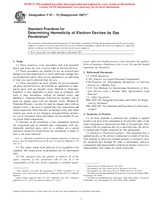We need your consent to use the individual data so that you can see information about your interests, among other things. Click "OK" to give your consent.
ASTM F97-72(1997)e1
Standard Practices for Determining Hermeticity of Electron Devices by Dye Penetration (Includes all amendments And changes 8/16/2017).
Automatically translated name:
Standard Practices for Determining Hermeticity of Electron Devices by Dye Penetration
STANDARD published on 10.12.1997
The information about the standard:
Designation standards: ASTM F97-72(1997)e1
Note: WITHDRAWN
Publication date standards: 10.12.1997
SKU: NS-57122
The number of pages: 3
Approximate weight : 9 g (0.02 lbs)
Country: American technical standard
Category: Technical standards ASTM
Annotation of standard text ASTM F97-72(1997)e1 :
Keywords:
Contamination-semiconductors, hermeticity determination, by dye penetration, practice,, Dye technique, hermiticity of electron devices, practice,, Electron tubes-hermeticity, Hermeticity-electron devices, dye penetration, practice,, Leak testing-electron devices, hermeticity, by dye penetration, practice,, Penetrant dye technique, hermeticity of electron devices, practice
Additional information
| 1. Scope |
|
1.1 These practices cover procedures that will normally detect and locate the sites of gross leaks in electron devices. 1.2 These procedures are suitable for use on selected parts during receiving inspection or to verify and locate leakage sites for production control. They are not quantitative; no indication of leak size can be inferred from the test. 1.3 These procedures are most suitable for use on transparent glass-encased devices; all methods are applicable to transparent parts with an internal cavity. Method A, Penetrant-Capillary, is also applicable to parts, such as terminals, end seals or base assemblies, without an internal cavity, and Method C, Penetrant-Pressure Followed by Vacuum, can be used on opaque parts with an internal cavity. Method B, Penetrant-Pressure, can also be used on opaque parts with an internal cavity if the part is opened after dye penetration and before inspection. Parts that have an internal cavity may either contain gas (such as air, nitrogen, nitrogen-helium mixture, etc.) or be evacuated. These procedures are not suitable for use on grease-filled components. 1.4 Because of the possibility of dye entrapment between the component and an attached part, components with mechanically attached parts, such as a radiator on a power transistor, should be tested before the attachment is made or after it has been removed. Note 1-Alternative methods for determining hermeticity of electron devices may be found in Practices F98 (see 2.1) and Test Methods F134 (see 2.1).1.5 The values stated in SI units are to be regarded as the standard. The values given in parentheses are for information only. 1.6 This standard does not purport to address all of the safety problems, if any, associated with its use. It is the responsibility of the user of this standard to establish appropriate safety and health practices and determine the applicability of regulatory limitations prior to use. For specific hazard statement, see Section 8. |
We recommend:
Technical standards updating
Do you want to make sure you use only the valid technical standards?
We can offer you a solution which will provide you a monthly overview concerning the updating of standards which you use.
Would you like to know more? Look at this page.




 Cookies
Cookies
